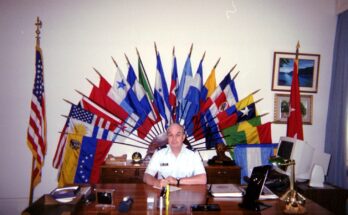In the Spring and Summer of 1941 England was fighting alone. Hitler had conquered all of mainland Europe. The Russians were standing on the sidelines as they had signed a non-aggression pact with Hitler in 1939. The English had evacuated their last defeated troops from Dunkirk on 4 June. There was little prospect that the U.S. would enter the war as Americans were opposed to getting involved in another “European War”. The U.S. Ambassador to England, Joseph Kennedy, had advised President Roosevelt that English surrender was a certainty. It was the darkest of times.
The English were totally dependent on vital supplies from abroad. Food, Fuel, and other vital necessities were being convoyed across the Atlantic. It was a minimum amount but the English were making do. It was a time when Winston Churchill was admonishing the English to “keep calm and carry on”. A convoy is only as fast as its slowest ship and the Nazi submarine “wolf packs” were reeking havoc. Sometimes sinking over half the ships in a convoy. The cargo ships badly needed more military escort vessels, especially destroyers to fend off the submarines.
Winston Churchill was repeatedly pleading with the U.S. to enter the war. Roosevelt was in a bind. He wanted to help England and was doing as much as the Lend Lease law allowed. Congress had declared the U.S. neutral and prohibited the transfer of war supplies to the combatants. Roosevelt took a political risk. In September 1940, he signed an “executive agreement” with Churchill to supply England with fifty ships. The ships were destroyers built during WWI and excess to the needs of the U.S. Navy. The executive agreement did not require congressional approval as it was not considered a treaty. In exchange for the ships, the British gave the U.S. 99-year leases for military bases in Newfoundland, Jamaica, Saint Lucia, Trinidad, Antigua, British Guinea and the Bahamas. Those bases greatly extended the reach of U.S. military power.
The fifty destroyers were rapidly put in order and assumed convoy escort duties. Convoy success rates improved dramatically as some Nazi submarines were sunk and others scared off. Some of the destroyers were used to escort supplies to Russia after Hitler violated his non-aggression pact and attacked Russia in June 1941. England and Russia signed an Anglo-Soviet agreement in July, and Russia joined the fight against Germany. England was no longer fighting alone. Part of the agreement stipulated that neither England nor Russia could sign a separate peace with Germany. It was to be a fight to the end.
Germany declared war against the U.S. on 11 December, 1941 and the U.S. congress declared war on Germany a few hours later. Now the might of the U.S. Navy was brought to bear against Nazi submarines. Within two years, only one out of five Nazi submarines leaving port would return.
Had not those fifty old destroyers been supplied to England when they were, England might have been forced to surrender. That would have left Hitler free to send the entire might of his military against Russia. Yes, the war might have ended differently but for those fifty ships.



